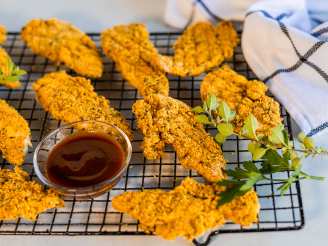Marinated Hooligan Fry (Aka Smelt or Eulachon)

- Ready In:
- 25mins
- Ingredients:
- 9
- Serves:
-
2-4
ingredients
- 8 hooligan fish (smelt)
- 9 tablespoons white vinegar
- 3 tablespoons granulated sugar
- 3 tablespoons soy sauce
- cornstarch (about 1/4 cup)
- oil (for frying)
- 1 cup thinly sliced onion
- 1 teaspoon salt (approximate)
- 1 whole red bell pepper, thinly sliced in rounds and seeds removed
directions
- Clean the fish: cut off the heads and tails, remove fins (either cut or pull them away). Slit the fish down the full length, cutting just as far as the backbone. Remove the entrails and rinse under running water and pat dry. Using the back of a spoon or your thumb, on the inside of the fish press hard all along the backbone. Pulling from the head-end of the fish, the spine and bones should lift free of the body.
- In a shallow container, combine the vinegar, sugar, and soy sauce and set aside.
- Dry the cleaned fish well. Thinly coat the dried fish in the cornstarch.
- In a heavy pot heat the oil to about 350 degrees F and fry the fish for 7 to 9 minutes until they are crisp and golden. Remove and drain on paper towels. Place cooked fish in the vinegar mixture to marinate.
- After slicing the onion thinly, sprinkle slices with salt. When the onion has become moist from the salt, rinse the slices well and drain thoroughly.
- Thinly slice the bell pepper into rounds and remove the seeds.
- Cover the fish with the onion and pepper slices and spoon the marinade over all. Allow fish to marinate for at least one hour before serving, occasionally spooning the marinade over. Serve hot or cold, whichever way is your favorite.
Questions & Replies
Got a question?
Share it with the community!
Reviews
Have any thoughts about this recipe?
Share it with the community!
RECIPE SUBMITTED BY
I'm from Alaska, a Tlingit (prounounced "klingit") native American and Norwegian. I love food! If I could live on the ocean, I would. Fishing is where I find peace. My name is Darrell but my nephew calls me "Uncle Dobo" and these days many family members do, too. Someday I hope my sisters will have RecipeZaar accounts, too, so they can share their recipes with all our family members more easily. :)
I'm good friends with <a href="http://www.recipezaar.com/member/39547">Julesong</a> and her husband <a href="http://www.recipezaar.com/member/39857">Steingrim</a>, and they're great cooks. They cook a lot more "ethnic" food than I'm used to - I'm more a meat and potatoes kind of guy - but I'm coming to like some of the food styles they eat a lot.
My nephew, Julesong, and myself are collecting native Alaskan recipes these days, so you'll soon be seeing some of them appear in my list. Julesong types them up for us (and maintains my Zaar account for me). The ingredients will probably be unusual for most Americans, but I think it's important to collect the information about our Native Alaskan American heritage and share it with others. My nephew Jared collected some of them from family members while visiting Anchorage.




